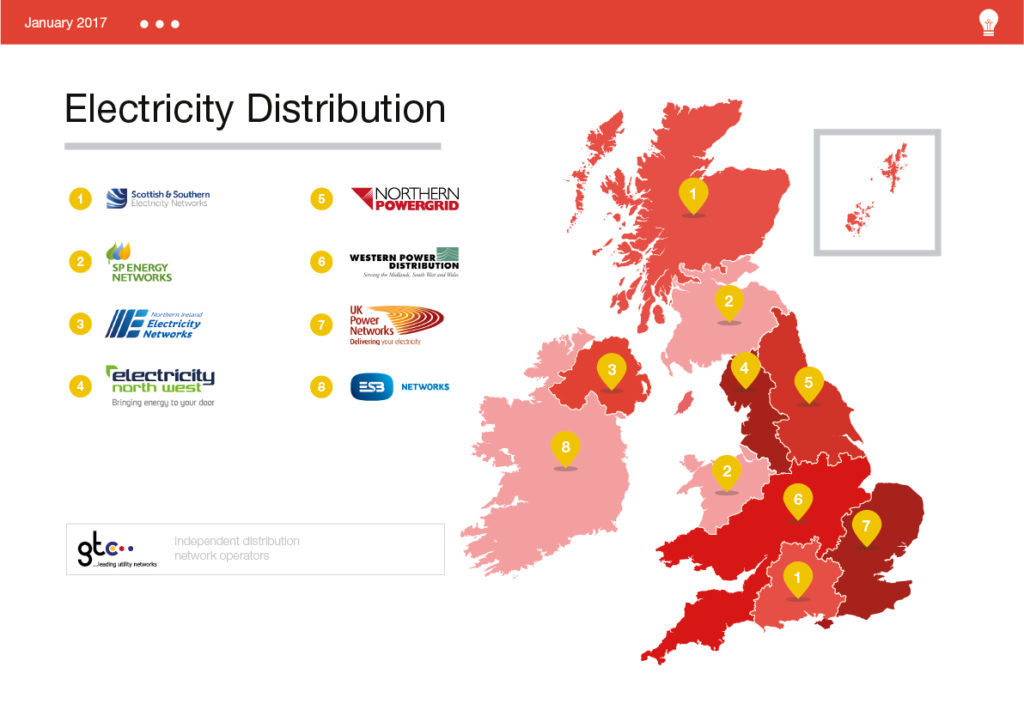The DUOS Distribution use of System is the recovering of the cost of distributing electricity across the national network. These Distribution Network Operators (DNO’s) distribute electricity around the UK- licensed by Ofgem. You might have noticed this charge on your electricity bill- everyone’s bill contains a charge which covers the cost of distributing energy and maintaining a safe and reliable electricity infrastructure. This transmission system is vast up and down the country between generators and end users such as homes and businesses. When we speak about the infrastructure, keep in mind we’re talking about overhead lines, underground cables and substations and transformers. There are six DNO’s in the UK mainland; Electricity North West, Northern Power Grid, Scottish & Southern Energy, Scottish Power, UK Power Networks and Western Power Distribution.
We’ve spoken before about the fact the energy industry is evolving- this is also true for electrical infrastructure. For the last 150 years, our energy supply has come from large centralised sources; power stations using nuclear, coal and gas and so this infrastructure was designed to cater to this. Nowadays, many of these power stations have closed and given way to a new age of energy as renewable power takes over- wind and solar power in particular. Since a main input into the system- the generated power from the power stations, no longer contributes to the system, and renewable power can have an intermittent input into the grid because of seasonal or weather changes, there needs to be a balance in the system when we suffer a shortage in supply- when supply is less than the demand. Along with the fact our supply can be considered to be more unstable now, as consumers, we now rely more heavily than ever electricity- our demand for electricity for everything from our cars to our smart technology- puts even more pressure on the National Grid.
For this reason, it’s necessary that changes are made; concentrating firstly on renewable energy, the smaller-scale renewable generation projects around the UK need to be connected to the National Grid. These could be a number of projects; solar photovoltaic (PV) panels, wind turbines, hydroelectricity, anaerobic digesters and micro combined heat and power (CHP) Due to the unreliability of renewable power, it’s best to have a higher level of renewable energy available to enter the grid to ensure the supply can match the demand even without the large scale power stations. If you’re interested in- or own- an electric powered car, you’ll be aware that the demand for new technologies isn’t slowing down, and so the energy industry has to be forward thinking to ensure they can meet the demand- meaning an expand of infrastructure is of an incredibly high importance.
As well as building more infrastructure to widen the are the National Grid can provide energy to, the DNO’s also need to replace old and out of date sections of the network. A large part of the network needs to maintain the network- replacing old and out of date sections of the network. Since the 1960s, fluid-filled cables have been used in the UK, according to the Energy Networks Association (ENA), “power lines at 275,000 volts and 400,000 volts and the strategic extra high-voltage distribution networks at 132,000 volts down to 33,000 volts. The fluid acts as an electrical insulator and is much less expensive than the next cheapest option. While the environmental risk associated with the leakage from old cables is low with only a very small percentage ever developing leaks, it remains a cause for concern.” In contrast, modern cable fluid is biodegradable and poses a minimal risk to the environment and so maintaining and monitoring the old cable whilst replacing it with the new cable is a constant job for the DNO’s.
So how does this affect you?
Now you know the science behind the system and why it’s necessary for the DNO’s to be working on the network, you can now see why as a customer you will see this charge on your energy bill. The charges are published once a year by each DNO in February for the period 1st April- 31st March. These charges will depend on a number of variants; meter type, voltage, location, profile consumption usage and authorised supply capacity. You will see these charges split into three elements on your invoice:
Unit Rate: A section of charges are added to your p/kWh unit rates and vary at different times of the day, the highest rates are during winter peak hours 4pm-7pm from November through to February.
Availability Charge: Covers the cost of providing capacity to meet your maximum demand. This works in line with your agreed change set with the DNO’s.
Daily Charge: Added into your standing charge this is a fixed cost charged by your DNO’s to recover their overheads and fixed costs.
The future of energy
We’ve mentioned how moving into the future the network will have to be expanded and replaced with new technology- this obviously won’t be cheap! It’s predicted that most DNO’s will be granted permission from Ofgem to collect further revenue from customers to cover this cost at around a 15% increase of charges.
Are you interested in getting your renewable generation project connected to the National Grid? If you are, or you’re interested in discussing any of the topics mentioned in this blog post further with an expert energy adviser, please get in touch– we’d love to hear from you!
(Photo above from the National Grid website)

